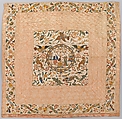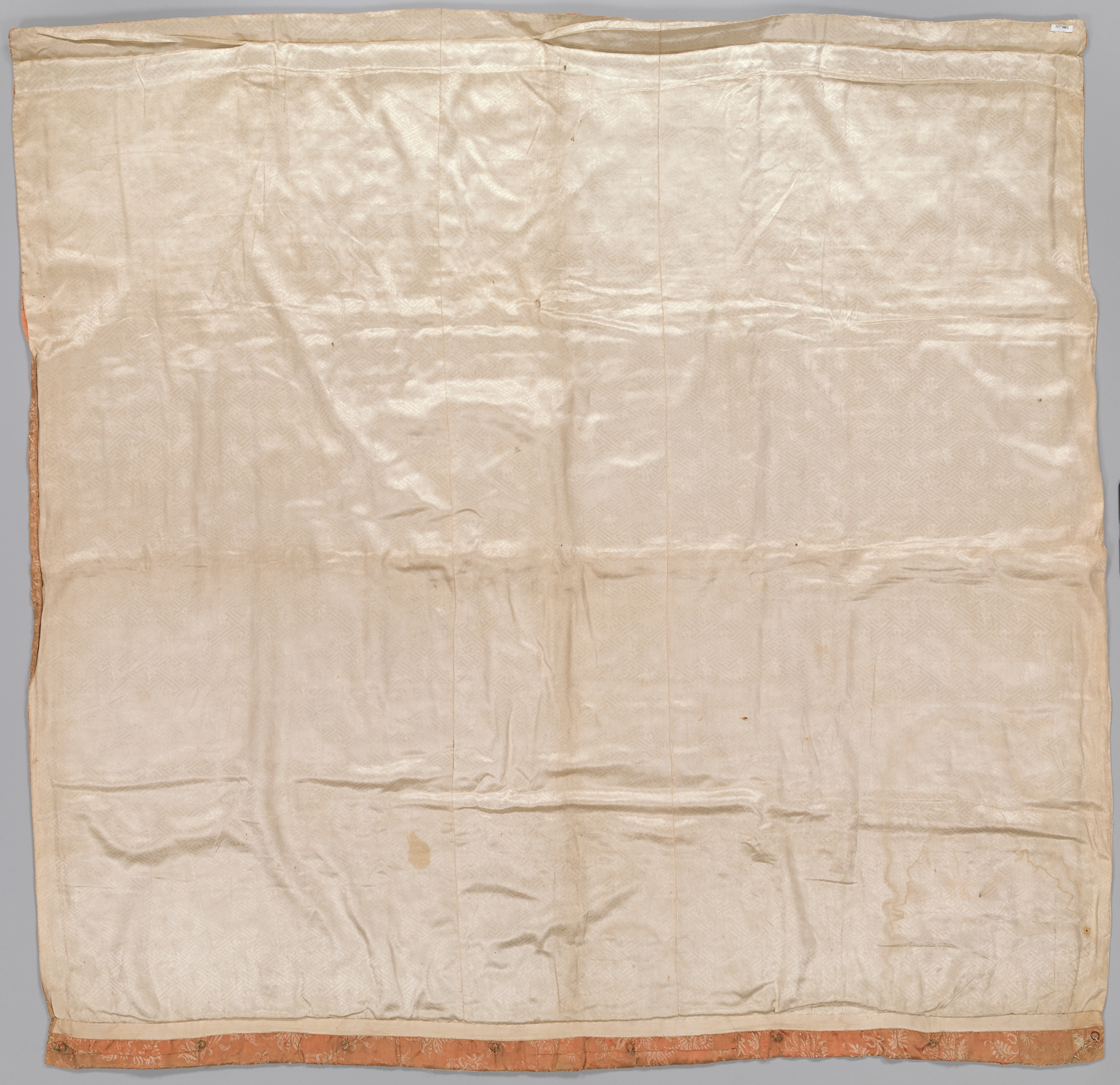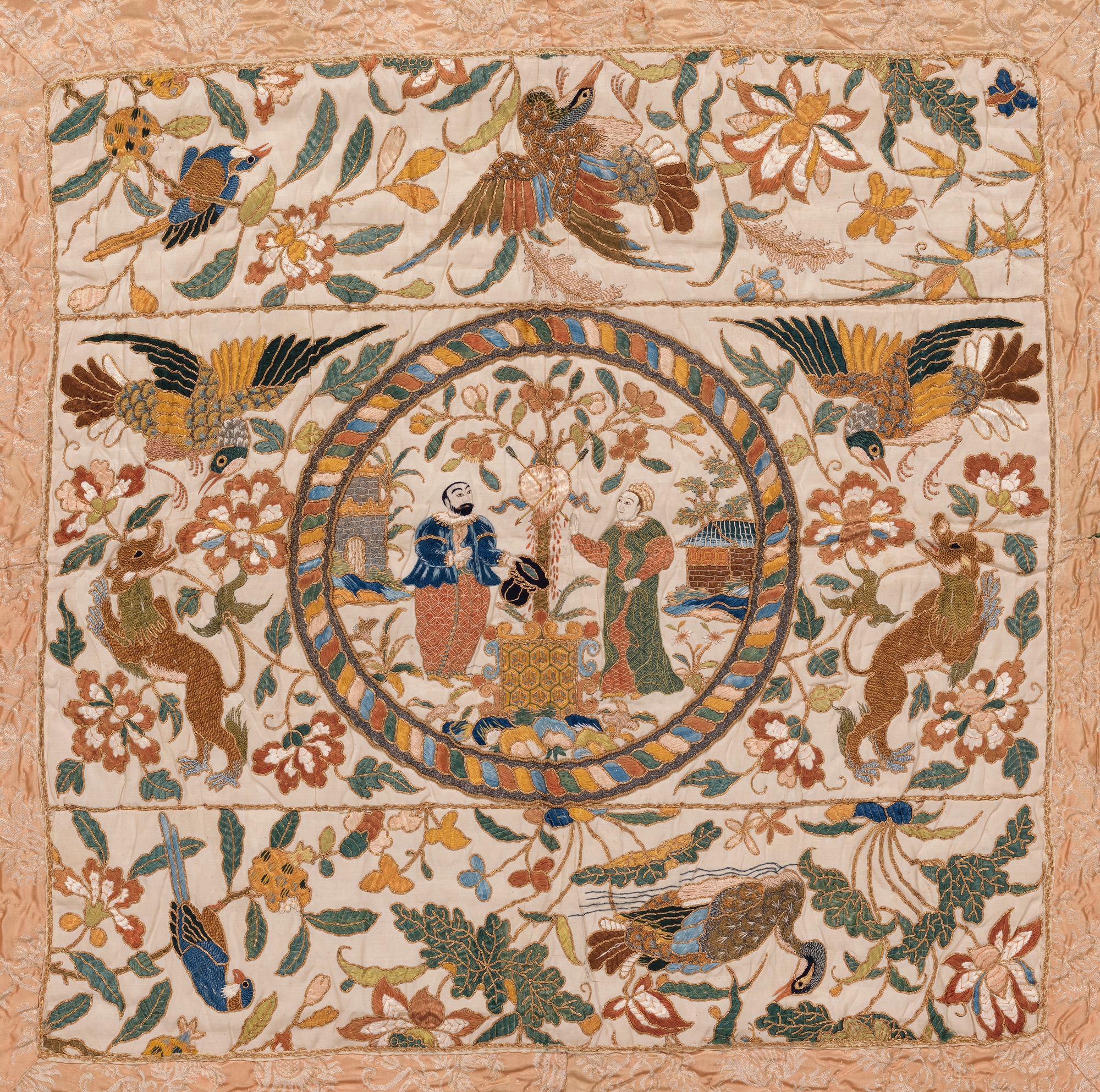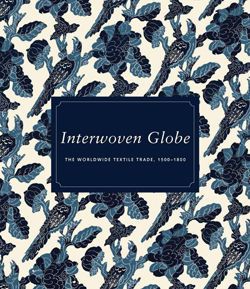Quilt
Chinese, for European market, and European
Not on view
The embroidered portions of this cloth were probably once part of a large marriage bedcover made in China for export. Later, the precious bedcover was cut up, and portions were pieced together with a delicate quilted European floral silk to create the panel as it appears today.[1] Its relatively small size indicates that it may have served as a christening or bearing cloth for a child being carried to the baptismal font for christening.[2]
At the very center of the textile are three bands from the original coverlet, one with a roundel containing a scene of a man and a woman flanking a tree, perhaps inspired by traditional depictions of Adam and Eve. The blossoming tree grows from a large container decorated with a continuous pattern of hexagons, a Chinese design suggesting longevity, and on the tree is a bleeding heart pierced with arrows, a secular symbol referring to love and devotion in Renaissance Europe.[3] The dress of the couple is generally consistent with that of late sixteenth to early seventeenth century Europe: the woman’s unstructured clothing is typical of the early seventeenth century, while the man’s hat conforms to late sixteenth-century examples.[4] Their garments are overembroidered with repeating Chinese patterns, as if made to resemble Chinese silk damasks.
The two other adjoining bands at the center of the panel were formerly one. If placed one directly above the other, they form a scene with a pair of ducks in a lotus pond. Although the lotus pond is an enduring theme in Chinese textiles, here the pattern shows a heightened emphasis on flower centers, common in Chinese export textiles, and another type of duck has been substituted for the pair of egrets or mandarin ducks more frequently found in a traditional Chinese image.
Another part of the original coverlet was retained as the embroidered border of the present panel; while its sides were heavily pieced together, the ninety-degree corners were untouched in the piecing process, indicating that it served as a border in the original coverlet as well. The delicate, light peach-colored European textile chosen to surround the exotic portions of the cloth has a floral pattern typical of the last decades of the seventeenth century.[5] The panel is fully lined in a white monochrome woven silk with a small floral pattern on a continuous fretwork background likely woven in China. Cloth of this type, termed rinzu, was exported from China to Japan in large quantities during the seventeenth century to be used as the foundation fabric of luxurious dyed and embroidered Japanese kimonos, until the Japanese started producing it themselves in the mid-Edo period, starting in the 1680s.[6]
[Melinda Watt, adapted from Interwoven Globe, The Worldwide Textile Trade, 1500-1800/ edited by Amelia Peck; New York: Metropolitan Museum of Art; New Haven: distributed by Yale University Press, 2013]
Footnotes
1. Chinese embroidered textiles on white silk were frequently used or reused in elite contexts in Europe. See Cammann and Blomqvist, Spansk korkåpa av kinesiskt broderi/A Spanish Cope Made from a XVIIth Century Chinese Embroidery. Cammann associates white grounds with manufacture in Guangzhou.
2. For further discussion of bearing cloths, see Cora Ginsburg LLC, A Catalogue of Exquisite and Rare Works of Art . . . Winter 2011 ・ 2012, p. 6.
3. Bayer et al., Art and Love in Renaissance Italy, p. 62.
4. For similar hats and facial hair in the dress of many of the male figures in a tapestry of 1597 ? 99, see Surprise Attack on Calais, in Campbell et al., Tapestry in the Baroque: Threads of Splendor, p. 56.
5. See, for example, Metropolitan Museum, acc. nos. 09.50.1196 and 09.50.1581; see also a textile reproduced in Ribeiro, Fashion and Fiction, p. 253, fig. 160.
6. Gluckman and Takeda, When Art Became Fashion, p. 338. See also Ogasawara, Some to ori no kansho ̄ kiso chishiki, pp. 243 ? 44. The lining may be a later addition
This image cannot be enlarged, viewed at full screen, or downloaded.
This artwork is meant to be viewed from right to left. Scroll left to view more.





